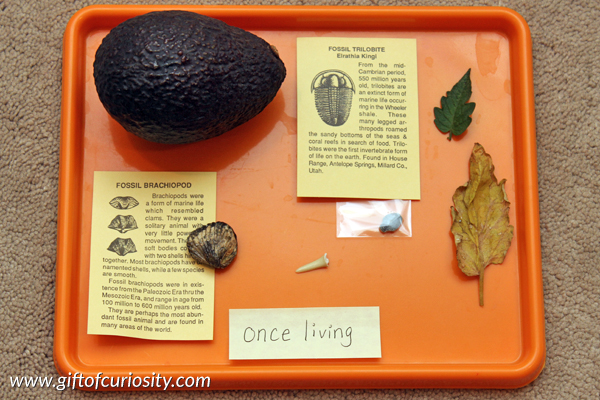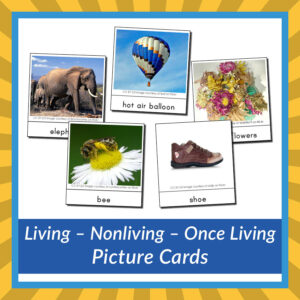This post may contain affiliate ads at no cost to you. See my disclosures for more information.
In a previous post I shared some hands-on activities and links to free printables for giving kids an introduction to living and nonliving objects. Once my kids understood the characteristics of living and nonliving things, I introduced the concept of once living. Once living things are objects that used to be alive, but now are not. For example, dried flowers, a dead insect, and a fossil would all be examples of once living objects.
Note: Looking for more Montessori inspired science activities? See my science activities for kids page and my Montessori activities page.
This unit turned out to be a bit tricker than I would have thought. As I shared these activities with my husband and mom, we got into some really interesting discussions about the difference between living, nonliving, and once living. For example, my kids would look at a t-shirt and categorize it as nonliving. But if the shirt it made from cotton, that cotton was once alive on a cotton plant, meaning that the shirt is technically once living.
Even something like plastic could be considered once living, since plastic is made from petrochemicals that come from carbon life forms that died hundreds of thousands of years ago. See how tricky this can get?!? 🙂
Once living tray
Needless to say, I kept it more simple and concrete for my kids. We started our introduction to once living things with this once living tray that included the following once living objects:
- an avocado
- a green leaf
- a brown leaf
- a shark tooth
- two fossils
For each object on the tray, we talked about how it had come from a living thing that needed food, water, air, and that could reproduce. (See our introduction to living and nonliving where I discuss these four characteristics.) But we also talked about how each of these objects was no longer living and thus no longer needed food, air, water, and could no longer reproduce.
Reading books about living and nonliving
Over the course of the unit, we also read many great books about living and nonliving.
Creating our own living / nonliving / once living books
To help drive home the differences between living, nonliving, and once living, I invited the kids to create their own Living / Nonliving / Once Living books.
I gave them three sheets of paper each, with one labeled “Living,” one labeled “Nonliving,” and one labeled “Once Living.” They searched through the pages of various magazines and catalogs to find images for each page.
After they found an image they liked, they cut it out and glued it on to the appropriate page.
Once they completed their books, we punched holes in them and bound them using our 1/2 inch booklet rings from Montessori Services.
Below are their completed Living pages.
As you can see from my daughter’s work on the right, she was really into cutting and pasting images.
And as you can tell from my son’s work on the left. . . he was not as enthusiastic about this activity and only did the bare minimum.
And I was okay with that.
Here are their completed Nonliving pages.
Here are their completed Once Living pages.
Sorting living / nonliving / once living picture cards
Finally, I created some living / nonliving / once living picture cards for the kids to sort. I handed them to the kids in a pile along with a three-part tray. The three sections of the tray were labeled “Living,” “Nonliving,” and “Once Living.”
As the kids sorted the pictures, we discussed why each item was categorized as living, nonliving, or once living.
In all, my kids sorted the following:
- Elephant
- Bee
- Crab
- Daffodils
- Apple tree
- Bird
- School bus
- Hot air balloon
- Snow gloves
- Boat
- Shoe
- Blocks
- Apple core
- Dried flowers
- Coconut
- Dolphin skeletons
- Dried peppers
- Hollow tree trunk
Want a copy of my Living – Nonliving – Once Living Picture Cards?
Add this product to your cart by clicking the button below!
More living and nonliving resources
More living and nonliving posts from Gift of Curiosity:














Oh that would be an interesting discussion, how far do you carry it, because like you said so many things could be once living… Now I’m thinking on this, love it!